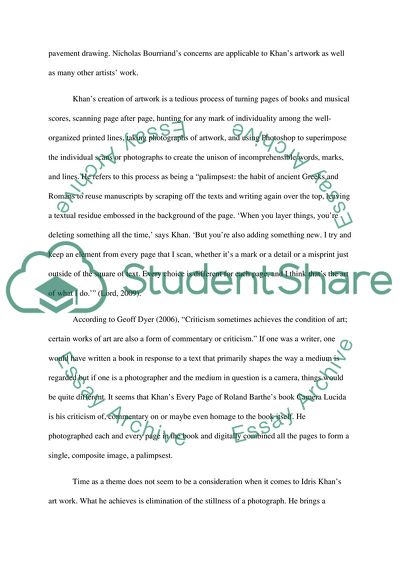Cite this document
(Idris Khans Photographic Practice Essay Example | Topics and Well Written Essays - 1500 words, n.d.)
Idris Khans Photographic Practice Essay Example | Topics and Well Written Essays - 1500 words. https://studentshare.org/technology/1737127-idris-khans-photographic-practice-involves-submitting-different-cultural-products-the-koran-camera-lucida-his-personal-holiday-snaps-to-the-same-photographic-montaging-process-how-should-we-understand-this-does-it-suggest-some-notion-of-cultura
Idris Khans Photographic Practice Essay Example | Topics and Well Written Essays - 1500 words. https://studentshare.org/technology/1737127-idris-khans-photographic-practice-involves-submitting-different-cultural-products-the-koran-camera-lucida-his-personal-holiday-snaps-to-the-same-photographic-montaging-process-how-should-we-understand-this-does-it-suggest-some-notion-of-cultura
(Idris Khans Photographic Practice Essay Example | Topics and Well Written Essays - 1500 Words)
Idris Khans Photographic Practice Essay Example | Topics and Well Written Essays - 1500 Words. https://studentshare.org/technology/1737127-idris-khans-photographic-practice-involves-submitting-different-cultural-products-the-koran-camera-lucida-his-personal-holiday-snaps-to-the-same-photographic-montaging-process-how-should-we-understand-this-does-it-suggest-some-notion-of-cultura.
Idris Khans Photographic Practice Essay Example | Topics and Well Written Essays - 1500 Words. https://studentshare.org/technology/1737127-idris-khans-photographic-practice-involves-submitting-different-cultural-products-the-koran-camera-lucida-his-personal-holiday-snaps-to-the-same-photographic-montaging-process-how-should-we-understand-this-does-it-suggest-some-notion-of-cultura.
“Idris Khans Photographic Practice Essay Example | Topics and Well Written Essays - 1500 Words”. https://studentshare.org/technology/1737127-idris-khans-photographic-practice-involves-submitting-different-cultural-products-the-koran-camera-lucida-his-personal-holiday-snaps-to-the-same-photographic-montaging-process-how-should-we-understand-this-does-it-suggest-some-notion-of-cultura.


